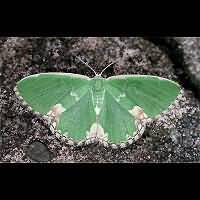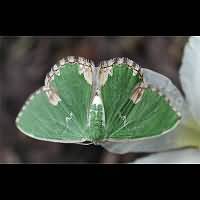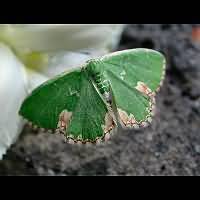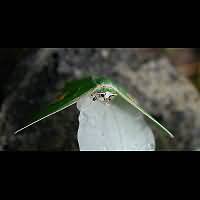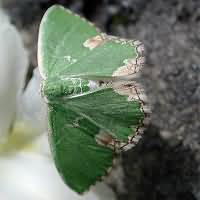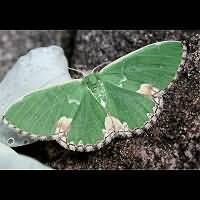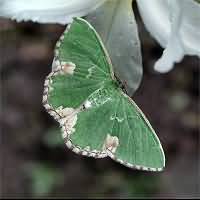Blotched Emerald (Comibaena bajularia)
The Blotched Emerald is among the most beautiful in our area. There are more green geometers, but this is the only one showing creamish blotches near the hind edge of both wings. Thus it is easy to indentify it, for there is no other species like it. Because of the bright colours this species is sometimes wrongly indentified as a butterfly. In old specimens the green colour is occasionally faded into pinkish or buffish white. The Blotched Emerald is extremely difficult to discover hiding among the leaves of trees, for it looks like an infested leaf very much. It is a rather small species, reaching a wingspan of some 29 to 33 mm only.
The Blotched Emerald flies about for a relatively short period only and is usually merely seen in June and July, especially in the UK. On the continent it sometimes flies till the end of August. The eggs don't hatch quickly after being laid. Only in September the first larvae appear. The caterpillars are also extremely difficult to discover. They cover themselves with pieces of leaves and other debris, looking like a very small pile of plant junk. It is only when this pile suddenly starts moving they catch the eye. The caterpillars themselves are brown with yellowish lines on the sides interrupted by reddish brown or black blotches. Furthermore there are a few white bumps to which the debris is spun. After having themselves camouflaged this way, the young larvae go into a long hibernation, only to wake in early May. After a few weeks the caterpillar spins together a few leaves, makes a flimsy kind of cocoon and pupates. The larvae are only found on oak.
The Blotched Emerald is a local species, but where present it may appear in great numbers. In the UK only found in the south, especially southern Engeland, where sometimes abundant. Scattered northwards to Yorkshire and eastern Wales. Not found in Scotland and Ireland. On the continent also found locally. Not a northern species, though. The males are easily attracted to light, sometimes in great numbers. Females are rarely seen in moths traps.
The Blotched Emerald is among the most beautiful in our area. There are more green geometers, but this is the only one showing creamish blotches near the hind edge of both wings. Thus it is easy to indentify it, for there is no other species like it. Because of the bright colours this species is sometimes wrongly indentified as a butterfly. In old specimens the green colour is occasionally faded into pinkish or buffish white. The Blotched Emerald is extremely difficult to discover hiding among the leaves of trees, for it looks like an infested leaf very much. It is a rather small species, reaching a wingspan of some 29 to 33 mm only.
The Blotched Emerald flies about for a relatively short period only and is usually merely seen in June and July, especially in the UK. On the continent it sometimes flies till the end of August. The eggs don't hatch quickly after being laid. Only in September the first larvae appear. The caterpillars are also extremely difficult to discover. They cover themselves with pieces of leaves and other debris, looking like a very small pile of plant junk. It is only when this pile suddenly starts moving they catch the eye. The caterpillars themselves are brown with yellowish lines on the sides interrupted by reddish brown or black blotches. Furthermore there are a few white bumps to which the debris is spun. After having themselves camouflaged this way, the young larvae go into a long hibernation, only to wake in early May. After a few weeks the caterpillar spins together a few leaves, makes a flimsy kind of cocoon and pupates. The larvae are only found on oak.
The Blotched Emerald is a local species, but where present it may appear in great numbers. In the UK only found in the south, especially southern Engeland, where sometimes abundant. Scattered northwards to Yorkshire and eastern Wales. Not found in Scotland and Ireland. On the continent also found locally. Not a northern species, though. The males are easily attracted to light, sometimes in great numbers. Females are rarely seen in moths traps.

